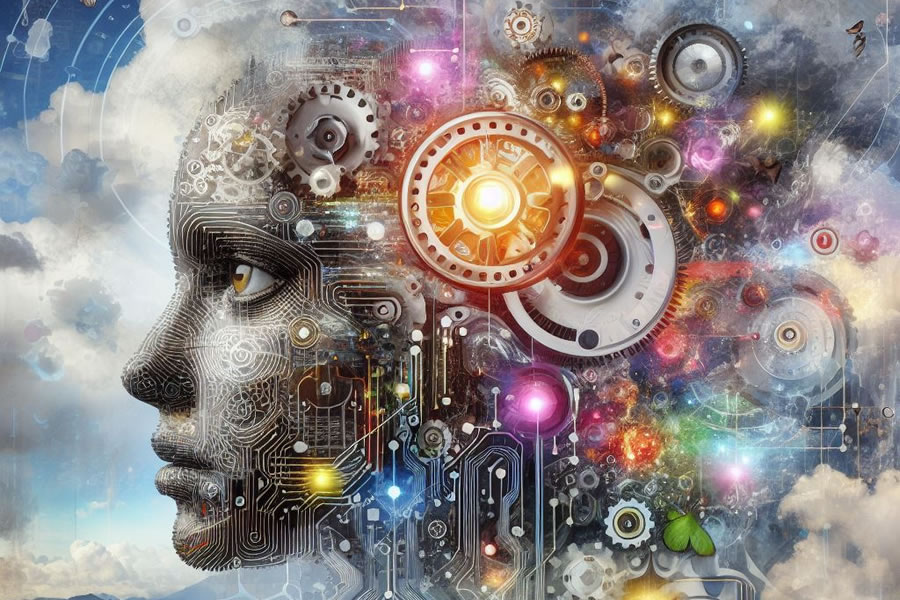Walking The Tightrope of Artificial Intelligence
“The illiterate of the 21st century will not be those who cannot read and write,
but those who cannot learn, unlearn, and relearn.”
– Alvin Toffler
I’m usually very good at controlling the tension in my life. However, every time I begin this article on AI and ChatGPT, I feel tension creeping across my forehead. This is my twelfth attempt in the past three months to tackle this subject.
Why the frustration? Every day, like an amoeba, AI spreads and learns in a very basic way. That is why it is CONSISTENTLY in the news.
Understanding Artificial Intelligence
What is AI? AI, which stands for artificial intelligence, is a technological advancement where machines or robots mimic human intelligence to carry out tasks.
ChatGPT is a natural language processing tool driven by AI technology that allows you to have human-like conversations and much more with the chatbot.
My personal concern: Being a member of SAG/AFTRA, I’ve been concerned as to how AI technology is becoming a threat to actors and screenwriters.
In addition, The Authors Guild (of which I’m a member), a U.S. trade group for writers, has recently proposed a class action against AI on behalf of 17 plaintiffs, including huge names such as Doug Preston, Suzanne Collins, Jonathan Frazen and John Grisham.
Oh yes! This morning I woke up to another giant leap, ChatGPT is learning how to see, hear, and speak! Wrap yourself around that idea. This is a massive step forward for all content creators and entrepreneurs.

Artificial Intelligence is everywhere and will continue to influence all our lives. Embrace it, play with it, and learn.
Throughout recorded history, there have been many major disruptions which have become entrenched in society. Think of the first car, the first computer and the internet. Consider how new digital technologies are changing the world. Self-driving cars? Yes.
I’m sure you can think of both positive and negative outcomes of these forces.
This proliferation is another indication that those who embrace technology have the advantage of making themselves indispensable. Those that don’t learn will be left behind.
What Are The Negative Aspects of AI?
Let’s examine the negative aspects of AI and ChatGPT. They can include:
1. Lack of empathy and human touch: AI lacks the ability to truly understand human emotions and empathy. While it can provide assistance and perform tasks efficiently, it may not be able to fully replicate the understanding and compassion that humans can provide in certain situations.
AI may not be able to understand or empathize with human emotions, leading to unsatisfactory customer experiences.
2. Security risks: With the widespread use of AI, there is a concern about potential security risks. Hackers and malicious actors might exploit vulnerabilities in AI systems, leading to data breaches, identity theft, or other security breaches.
3. Ethical considerations: AI raises ethical questions, such as privacy concerns, algorithm biases, and the potential misuse of data. It’s crucial to develop AI systems with transparency, fairness, and accountability in mind, to prevent unintended consequences and ensure ethical decision-making.
4. Dependency and loss of skills: Over-reliance on AI can lead to a decline in certain skills. For instance, if AI takes over tasks like critical thinking or problem-solving, humans may lose the opportunity to develop and utilize these skills effectively.
5. Inability to handle complex situations: While ChatGPT can handle a wide range of questions and provide general information, it may struggle with more complex or specific situations that require deeper analysis or human judgment. It’s important to recognize the limitations of chat AI when dealing with intricate or sensitive matters.
6. Misunderstandings: ChatGPT can misunderstand the context of a conversation, leading to incorrect responses or confusion.
7. Limited functionality: is limited to pre-programmed responses, which may not cover all possible scenarios.
8. Privacy concerns: ChatGPT may collect and store personal information, leading to privacy concerns and potential data breaches.
9. Job displacement: As AI technology advances, there’s a worry that certain jobs may become automated, leading to job losses for humans. The issue? AI can enhance productivity
Did I write these potential downsides to AI? NO!!!
I asked Chat AI what the downsides were and what you read above is what I received. Despite these negative aspects AI can be addressed through responsible development, regulation, and the ethical use of AI.
AI is everywhere and will continue to influence all our lives.
Embrace it, play with it, and learn. It can have tremendous advantages in our daily lives. Here are 10 positives to AI and Chat AI.
Now, What Are The Positive Aspects of AI?
There are several advantages to using chat-based communication:
1. FUN: Yes fun! You can ask AI anything and find out if it compares to your knowledge. This can only support you in your knowledge growth.
AI can provide valuable assistance, quick information, and convenience. It’s important to utilize it wisely while being aware of its limitations.” Once you get into this you must ‘fact check’ the information.
2. Convenience: Chat allows for asynchronous communication. Writer/Editor Sophia Barron writes “Asynchronous communication is any type of communication where one person provides information, and then there is a time lag before the recipients take in the information and offer their responses.
Simply put, asynchronous communication is communication that does not have to happen in real-time (e.g., on the phone, in-person, or during a live video conferencing meeting).
This lack of real-time communication is becoming increasingly prominent in the workplace, making it easier for employees to work remotely without fear that they’re missing out on critical conversations happening at the office.
3. Medical diagnostics: AI is changing the medical field. According to the ‘National Center for Biotechnology’, Artificial intelligence (AI) is being used more and more regularly, particularly in diagnosis and treatment planning. AI and machine learning have become effective diagnostic tools in recent years.
Here is a mind-blowing fact. The average accuracy of doctors is 71.40% while AI is 77.40%!
4. Improve the educational system: Contrary to the negative downside of AI such as cheating and plagiarism, the upside is huge.
Keep in mind that ChatGPT is a technology that uses artificial intelligence and machine learning to provide human-like responses to THE user. Therefore, ChatGPT can facilitate education by evaluating students, providing feedback, automating administrative duties such as grading and improving curriculum.
I found an article by Diane Adame of WGBH News that talks about Andre Wangard who teaches world history at Cristo Rey Boston High School in Boston, Massachusetts. She uses an AI chatbot to help students go back in the past to quiz long-dead historical figures She writes, “The 11th graders asked Genghis Khan and Confucius about Asia’s economic systems — and through an artificial intelligence chatbot, those long-dead figures answered back.
The AI answers may or may not be correct — one of the big problems with generative AI technology — but Wangard’s students are delighted by the ability to have a simulated conversation with historical figures.”
“We were able to actually ask a person from the past questions and get a better answer than what the textbooks would give you,” one student said excitedly. So, of course I had to try it. Asking ChatGPT a few questions I was able to get a historical response asking a question to AI Chat and getting a response ‘as if’ I was conversing with Mark Twain.
5. Availability 24/7: AI systems can work around the clock without needing rest, making them ideal for customer service and support.
6. Flexibility: ChatGPT can be accessed on numerous devices, making it easy to communicate from smartphones, tablets, or computers.
7. Enhance Innovation: Artificial Intelligence (AI) has the potential to drive human innovation in several ways. It can help businesses develop new products and services, leading to innovation and growth.
According to a Forbes article, Three Ways Artificial Intelligence Can Drive Human Innovation, AI can increase human innovation by creating space for innovation, generating novel patterns, and democratizing creativity. By automating low-impact tasks, AI can free up professionals’ time and energy, allowing them to focus on more innovative endeavors. Additionally, AI can identify new patterns and insights that humans might not have discovered on their own. This can lead to novel approaches and combinations that would not have been possible without the collaboration between humans and machines. While AI is not inherently creative, it can serve as a catalyst for human creativity by providing new perspectives and ideas.
8. Multitasking: ChatGPT enables you to have multiple conversations simultaneously, making it suitable for multitasking. I’m not a great fan of multitasking but nevertheless, it is extremely helpful in the workplace, remote or in person.
9. Improve decision making: Scarlett Rose write in ‘Becoming Human Artificial Intelligence Magazine’,
“AI has the ability to augment human intelligence and enable smarter decision-making. Artificial intelligence helps in detecting wrong decisions and thus speeds up the entire process of decision making.”
10. Global Reach: Chat breaks down all geographical barriers, allowing you to communicate with people around the world in real-time.
FINAL ADVICE: Do not totally trust AI. Use it as you would Google or other search engines. You can glean powerful information by just asking a question. Then, it’s up to you to verify.
Keep in mind, AI does not have a soul. It cannot feel or express empathy…. YET.
IMAGINE THAT!
James Mapes is a keynote speaker, best-selling author, coach and hypnotist. His most recent book IMAGINE THAT! Igniting Your Brain for Creativity and Peak Performance is the first web-supported book with access to 21 video-coaching clips.

James Mapes is the founder of Quantum Leap Thinking™, creator of The Transformational Coach™, expert on the psychology of “applied imagination,” best-selling author, highly acclaimed business speaker, consultant, seminar leader and personal excellence coach.
